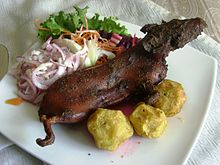Cuy
Under Cuy or giant guinea pig (from the Quechua Quwi for guinea pigs ) particularly large forms of be in German-speaking house guinea pig ( Cavia porcellus ) understood. Since in South America all guinea pigs - especially different (sub) species of the wild guinea pigs ( Cavia aperea ) - are understood under this term, confusion occurs again and again.
description
Cuys originally come from South America , where they are kept as fattening animals . There the animals have different types of fur, such as B. long hair, straight hair or crested. The Cuys bred in Germany come from a few animals from South America. In the meantime, different types of fur such as straight hair and rosette have emerged.
In contrast to a normal house guinea pig, which is fully grown at the age of one and then weighs around 1, in rare cases up to 1.5 kg, a Cuy already reaches this weight at four months. The final weight of a Cuy is 2-3 kg. The body length of a fully grown Cuys is on average 27-35 cm. The so-called “Cobayos” (as Cuys are often called in Perú), which can reach a body length of 50 cm and a weight of 4 kg, are an exception. However, the term cobayo , which comes from the Tupi language , is also used to refer to all types of guinea pigs. Cuys are mainly available in light color combinations, for example white with cream colors. Light colors are chosen deliberately, as meat bodies with dark skin are considered unaesthetic .
As with domestic guinea pigs, the gestation period is very long at 68–73 days for a mammal of this size. The litter size varies between 1 and 8 animals, the birth weight, depending on the litter size, is 80–250 g per animal.
The animals live to be around 2-3 years old. The Cuy accumulates fat very quickly if there is a plentiful diet. This affects your cardiovascular system and liver and can lead to serious illness.
Farm animal
Guinea pigs are eaten in the Andean region in Peru , Bolivia , Ecuador, and Colombia . In Peru, up to 65 million guinea pigs are eaten a year, but only a fraction of them are Cuys. Most of the guinea pigs eaten in Peru weigh between 500 and 600 grams. In the meantime, it has been possible to breed larger specimens in Peru that weigh around one kilogram.
As farm animals, Cuys have low requirements. Therefore the animals are often kept by small farmers in small stalls or in the house. Cuys are well adapted to life at high altitudes. They are mainly fed with kitchen waste and are therefore inexpensive meat suppliers for the poorer population. In the meantime, however, the animals are also offered in some urban restaurants in Lima , Cusco or Arequipa . Cuys are also eaten at the traditional Peruvian wedding meal. For the rural population, they are an everyday food and an important source of protein. The taste should be similar to that of rabbits . A traditional recipe is cuy chactado .
In addition, guinea pigs were used in traditional medicine. “Although it is now officially banned, Cuys are still used for healing purposes today. A living Cuy is driven over the patient's body, supposedly squeaking when it reaches a sick spot. The treating healer then kills the animal and opens it in order to make a diagnosis after examining the organs of the dead Cuys. "
Pet
Cuys are not suitable as cuddly toys because they take up a lot of space and are very shy. Cuys need a quiet environment, which practically rules out keeping these animals as pets for children. The animals often react frantically to unexpected noises or movements, which can easily lead to panic in a group and thus to injuries.
In Germany, Cuys are mainly kept by enthusiasts and cannot be bought in pet shops.
In South America there are often animals with polydactyly , i.e. with too many toes, as such animals were considered particularly fertile for the Indians . In the large breeding farms, attention is paid to normal-toed animals. In Europe and North America attempts are being made to breed out polydactyly, which is understood as a genetic defect.
Mating common house guinea pigs with Cuys is possible, but dangerous. The enormous size of a Cuy male is passed on to the young. This means that the likelihood of complications during pregnancy and childbirth (rupture of the uterus, obstructed labor, death) is very high.
literature
- Lilia Chauca de Zaldívar: Producción de cuyes (Cavia porcellus) (= FAO Animal Production and Health Paper. Vol. 138). Organización de las Naciones Unidas para la Agricultura y la Alimentación, Rome 1997, ISBN 92-5-304033-5 .
- Marta Cadena-Arias: Cuys. Giant guinea pig. Cavia aperea f. porcellus (= NTV small mammal library. Vol. 8). Natur-und-Tier-Verlag, Münster 2008, ISBN 978-3-86659-050-2 .
Web links
Individual evidence
- ↑ Lilia Chauca de Zaldívar: Producción de cuyes (Cavia porcellus). 1997, online .
- ↑ Spiegel article on breeding super guinea pigs (2004) .
- ↑ Frank Herrmann: Peru, West Bolivia. 2nd, completely revised edition. DuMont-Reiseverlag, Ostfildern 2007, ISBN 978-3-7701-6143-0 , p. 223.




